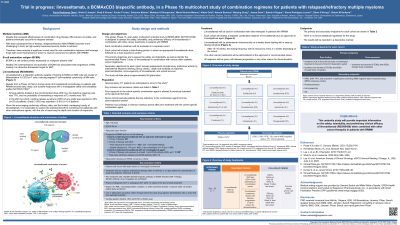Cellular and T cell engager Immunotherapy
Poster Session 1
P-046: Trial in Progress: Linvoseltamab, a BCMAxCD3 bispecific antibody, in a Phase 1b multi-cohort study of combination regimens for patients with relapsed/refractory multiple myeloma
Wednesday, September 27, 2023
1:30 PM - 2:30 PM EEST

.jpg)
Paula Rodríguez-Otero, MD, PhD (she/her/hers)
Associate Professor
Clínica Universidad de Navarra, CIMA, CIBERONC, IDISNA, Pamplona, Spain
Pamplona, Navarra, Spain
Introduction: Trial in Progress.
Despite the increased effectiveness of combination drug therapy, multiple myeloma (MM) remains incurable, and patients eventually succumb to relapsed disease. Therefore, new combination regimens are needed to improve outcomes in MM. Linvoseltamab is a bispecific antibody capable of binding to B-cell maturation antigen (BCMA) on MM cells and CD3 on T cells, inducing targeted T-cell-mediated cytotoxicity of MM cells. Results from a Phase 1/2 first-in-human study of linvoseltamab monotherapy in relapsed/refractory MM (RRMM) showed early, deep, and durable responses with manageable safety and tolerability (NCT03761108; Bumma N, et al. Blood. 2022;140(Suppl 1):10140–1). Given these findings, it is reasonable to explore whether combining linvoseltamab with other drugs can improve the depth and duration of responses.
Methods: LINKER-MM2 (NCT05137054) is a global, Phase 1b, open-label, multi-cohort study designed to assess the safety, tolerability, and efficacy of linvoseltamab in combination with nine different agents (daratumumab, carfilzomib, lenalidomide, bortezomib, pomalidomide, isatuximab, fianlimab, cemiplimab, or nirogacestat) in separate cohorts of participants with RRMM. Prior exposure to a combination agent is allowed if previously tolerated at the full dose (after a minimum washout period), although some cohorts exclude patients with disease refractory to the cohort-specific combination treatment. The study includes a dose-finding portion to select an appropriate linvoseltamab dose, followed by a dose-expansion portion for each cohort. Linvoseltamab is administered intravenously starting on a weekly basis from initiation of the step-up schedule through the first 15-16 weeks and then transition to every 2-3 weeks. All regimens are given until disease progression or any other reason for discontinuation. Estimated total enrollment is ~315 participants. Eligible patients are 18 years or older with RRMM that progressed after ≥3 lines of therapy, have an Eastern Cooperative Oncology Group performance status ≤1, and have adequate organ function. Key exclusion criteria include the presence of MM brain lesions or meningeal involvement, and previous treatment with certain BCMA-directed therapies depending on the cohort. The primary endpoint is safety and tolerability of each linvoseltamab combination, in terms of dose-limiting toxicities (dose-finding portion only) and treatment-emergent adverse events. Secondary endpoints are objective response rate, duration of response, progression-free survival, minimal residual disease status, pharmacokinetics, immunogenicity, and overall survival. This study is actively recruiting participants and anticipated to open at 50 global sites.
Results: n/a
Conclusions: Analyses from the LINKER-MM2 study will provide important information on the tolerability and preliminary clinical efficacy of linvoseltamab when given in combination with other cancer therapies, aiming to improve care for patients with RRMM.
Despite the increased effectiveness of combination drug therapy, multiple myeloma (MM) remains incurable, and patients eventually succumb to relapsed disease. Therefore, new combination regimens are needed to improve outcomes in MM. Linvoseltamab is a bispecific antibody capable of binding to B-cell maturation antigen (BCMA) on MM cells and CD3 on T cells, inducing targeted T-cell-mediated cytotoxicity of MM cells. Results from a Phase 1/2 first-in-human study of linvoseltamab monotherapy in relapsed/refractory MM (RRMM) showed early, deep, and durable responses with manageable safety and tolerability (NCT03761108; Bumma N, et al. Blood. 2022;140(Suppl 1):10140–1). Given these findings, it is reasonable to explore whether combining linvoseltamab with other drugs can improve the depth and duration of responses.
Methods: LINKER-MM2 (NCT05137054) is a global, Phase 1b, open-label, multi-cohort study designed to assess the safety, tolerability, and efficacy of linvoseltamab in combination with nine different agents (daratumumab, carfilzomib, lenalidomide, bortezomib, pomalidomide, isatuximab, fianlimab, cemiplimab, or nirogacestat) in separate cohorts of participants with RRMM. Prior exposure to a combination agent is allowed if previously tolerated at the full dose (after a minimum washout period), although some cohorts exclude patients with disease refractory to the cohort-specific combination treatment. The study includes a dose-finding portion to select an appropriate linvoseltamab dose, followed by a dose-expansion portion for each cohort. Linvoseltamab is administered intravenously starting on a weekly basis from initiation of the step-up schedule through the first 15-16 weeks and then transition to every 2-3 weeks. All regimens are given until disease progression or any other reason for discontinuation. Estimated total enrollment is ~315 participants. Eligible patients are 18 years or older with RRMM that progressed after ≥3 lines of therapy, have an Eastern Cooperative Oncology Group performance status ≤1, and have adequate organ function. Key exclusion criteria include the presence of MM brain lesions or meningeal involvement, and previous treatment with certain BCMA-directed therapies depending on the cohort. The primary endpoint is safety and tolerability of each linvoseltamab combination, in terms of dose-limiting toxicities (dose-finding portion only) and treatment-emergent adverse events. Secondary endpoints are objective response rate, duration of response, progression-free survival, minimal residual disease status, pharmacokinetics, immunogenicity, and overall survival. This study is actively recruiting participants and anticipated to open at 50 global sites.
Results: n/a
Conclusions: Analyses from the LINKER-MM2 study will provide important information on the tolerability and preliminary clinical efficacy of linvoseltamab when given in combination with other cancer therapies, aiming to improve care for patients with RRMM.
